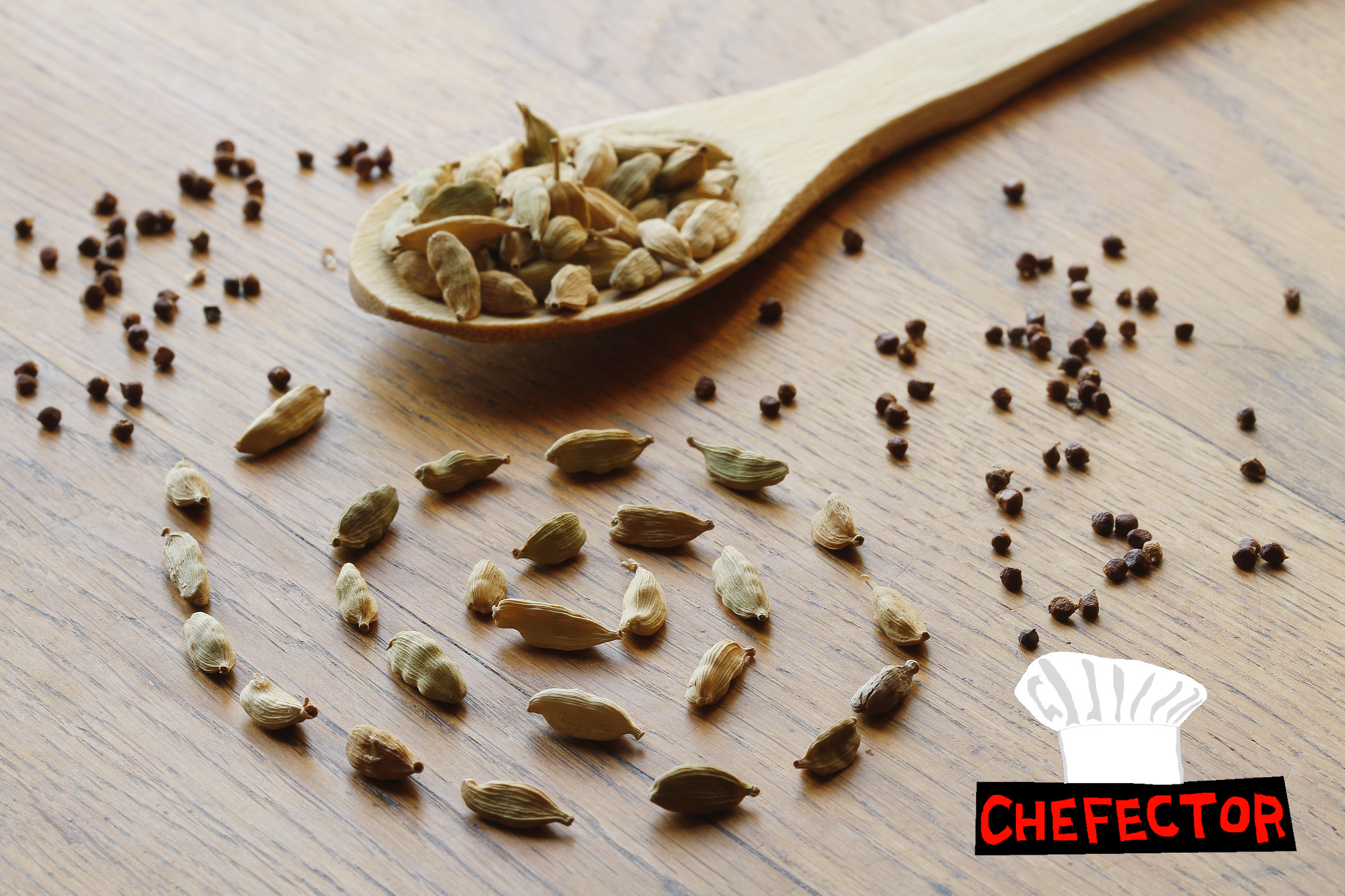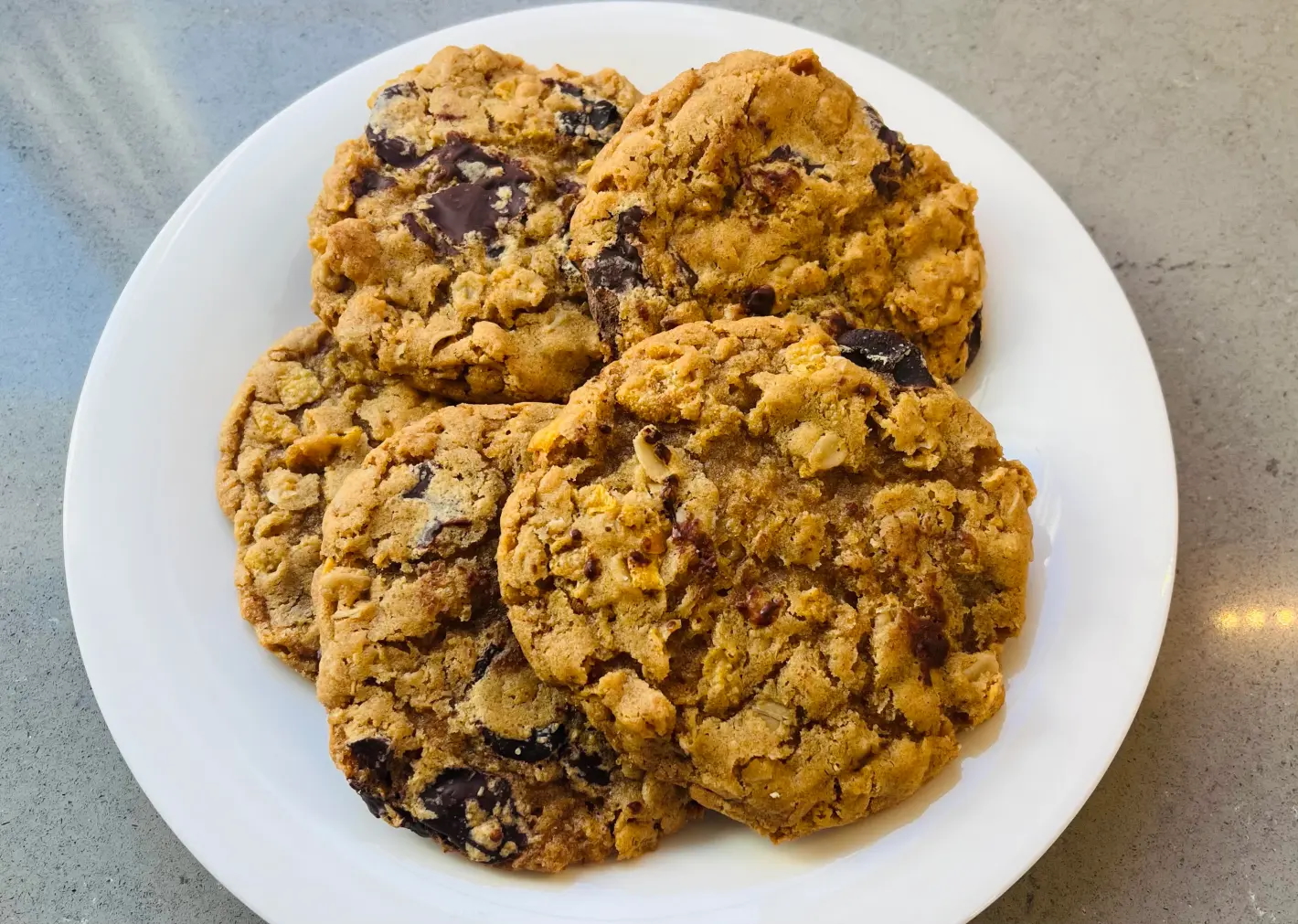Like all science-respecting human beings on the planet, I joined the communal descent into fear and anxiety last spring. I broke into uncontrollable tears without provocation and played video games till 3 a.m. But equally powerful to my fear of COVID's disruption of life was the horrifying realization that what everyone else was exploring, in order to cope with the angst of lockdown, was something I’d already been doing for years, and no longer found comforting: cooking. Every day, in the newspaper, on blogs, on social media, I read with growing dismay about how people all over the world were teaching themselves to explore their kitchens. Instagram was flooded with photos of someone’s first successful batch of brownies; Twitter was awash with proud faces holding aloft their first, second, third, 10th fresh sourdough loaves. Even The Great British Bake Off, a TV program I considered so dear to my heart because I was always inspired by it, felt numbing. I watched it listlessly, eyes glazed over, hoping to feel anything, and never succeeding.
My first conscious thought, upon waking each morning, used to be, Ugh, I’m still alive? Followed immediately by, Hmm, what might I eat today? The latter made the former tolerable, agreeable. I used food to plan my day; I looked to food as a balm, as a joy, one of the few good things left about being a human being on Earth. But the pandemic had slithered into my soul, gripped my heart tight as it pushed me outside myself. Any glimpse of my love for the kitchen felt as though I stood in a western town, a blizzard raging around me, my destination visible as a single burning oil lamp in a far-off cottage window. Visibility dropped, frequently, often completely, and I’d find myself lying face-down in the (metaphorical) snow. In the depths of my depression, I managed to find a small sliver of light. Whenever I did something radically new in the kitchen, something I truly had never done before, some life within me flickered. My boyfriend and I began making pasta from scratch using my stand mixer—previously used only for baking—and, just briefly, I accessed my pre-COVID state of mind.
On two occasions, the flicker deepened into something stronger. The newness of making fresh pasta had oxidized after approximately four straight weekends of rolling out dough, different flavorings worked in, resting the rapidly repetitive rigatoni (or penne or gemelli), boiling, eating, cleaning. The boredom was pervasive, and frightening. COVID's ubiquity seemed an existential version of my own localized inability to escape inside and to my own kitchen. At some point, however, Nigella Lawson tweeted that water used to boil pasta (or potatoes) could be added to bread dough, thereby aiding the rise with its starchy contents. Given how dazed I constantly felt, this advice felt like a gong, ringing magnificently through the film that coated everything I held dear. And indeed, a bread loaf, flavored with rosemary-garlic pasta water, ballooned beautifully and tasted marvelous.
That was the first occasion. The second took place well over a year later; I left the apartment my boyfriend and I now share, to make dessert at my mother’s house. She was holding a luncheon for some colleagues. Though she insisted a simple pound cake would suffice, I couldn’t bear the thought of people eating and admiring my mother’s extraordinary Indian cooking, and then, excited to taste my contribution, be served just an ordinary pound cake with their chai.
So I improvised. The day before, I’d made an ordinary vanilla custard, slapped clingfilm on the top, and stashed it in the fridge. A familiar, and not unpleasant, fear of the unknown thumped in my heart as I thought about what exactly I wanted to serve with the custard. Trifle seemed like a good way to use the custard, but plain pound cake? Boring. Rooting about my mother’s spice cabinet, I spotted whole cardamom in her jar of garam masala ingredients. Hm, why not? It added depth to chai, it was used in countless Indian sweets. A risk, I concluded, worth taking. I wiped out the spice grinder, blitzed a ⅛ cup of cardamom pods into fine powder, and added them as part of the dry ingredients to Jacques Pepin’s pound cake recipe. As the cake cooled I whipped cream to soft peaks, but added no powdered sugar. I chopped up the last of the summer mangoes—lissome and succulent and gorgeous in their yolk-hued glory—tossed them in just a splash of lemon juice, and kept them cold. Now, as I prepared to serve something I’d never made nor seen a recipe for, I melted sugar for caramel in a saucepan, brushing the sides of the pan minimally with water, and splashed in heavy cream just as the color went from marigold to chestnut. On a sheet pan covered in foil I’d sprinkled out roughly chopped cashews; over these I poured my caramel, and allowed it to harden into brittle. The final presentation: a base of the pound cake, followed by a layer of the custard, then one of chopped mango, then dollops of whipped cream, repeat, until the top of each glass was full. Right before I served, I topped each with the cashew brittle.
All 10 dessert bowls were wiped clean.
And, more importantly, I’d wandered into a haven from which I’d felt evicted for almost two years. I recognized in my veins and muscles the same frisson of anxiety: Will this turn out alright? Will it at least be edible? Will it give anyone cancer? My clinically anxious mind sought refuge in the eternal quest for perfection and order, to which baking is suited so very well. Just like that, neurons were firing again. I felt just a tiny bit proud. I felt competent. When I sat down at my mother’s dining table, apron still around my neck and waist, sweat generously pooling at my neck, I smiled.
Elaichi (ee-lai-chee), or cardamom, is so integral to Indian cuisine that I’ve always taken it for granted. It’s in readymade spice blends at the Asian grocery store, especially garam masala, the mother blend of spices integral to savory Indian cooking (with slight variations depending on region). Its presence adds a surprising depth to rusks, the thick Indian biscotti customarily dipped into tea in the afternoons. Chai lends itself to elaichi brilliantly, adding a restorative aroma to the most common camel-colored beverage sipped daily by billions. In my own family, the ingredient’s presence was always accounted for: My parents’ or grandparents’ hands would rummage round the dank and dark spice cabinet for the jar of whole cardamom pods. Some were plopped into a pot of rice that would shortly be boiled for lunch; others went into chai, still others into marinades. Because of its herbal, almost vegetal strength, cardamom is very easily overused, and can lead to a dish tasting bitter, whereas not adding enough is the same as not including it at all.
Oddly enough, my first exposure to cardamom was via its exclusion. Because it is primarily used whole, my parents and grandparents made sure to remove it from a pot of steamed basmati rice, risking burns from the fluffy snowy mounds as they fished out the desiccated green husks. In dishes where removal wasn’t possible, we had to remove them from our bites as we ate. Many an Indian childhood includes at least one memory of biting down on a whole elaichi pod while eating biryani, fish curry, paneer, vegetable stews, or meat dishes. Flooding your mouth with the post-cooked bitterness of cardamom—or the sodden bark of a nutmeg pod, or the roaring sensation of a large clove pod, or crunching through whole fiery peppercorns—is a formative experience, because eventually, your mouthfeel reflexes improve to the point that your tongue will sense the shape and taste of a whole spice, allowing you to remove it without ever biting into it. I prided myself on this expertise, lining up neatly along the edges of my plate all the whole spices I’d found in my plate of food.
Since cardamom provides a strong, almost heady herbal flavor to a dish, it is rarely used alone. It truly shines when its proportions are in harmony with other flavoring agents. In chai, elaichi must exist peacefully with, say, ginger, or sugar. If you add too much of both, you’ll feel as though your head’s been shoved into the soil of your herb garden. If you don’t use enough of both, you’ll wind up with an acceptable cup of tea, but not a transformative one.
I’d also be remiss in my mission to honor cardamom if I didn’t address its secondary characteristic, that of an ingredient, not just a spice. When my mother makes paneer—a curry dish that features fleshy cubes of Indian cottage cheese—she treats the elaichi pods in the same way she treats the tomato-onion-garlic-ginger base of her curry; the pods are still present in the final product as part of the sauce. Cardamom is strong enough to be used whole, and it exists not just to flavor, but to bring a dish to its ideal harmonic stage.
I still remember my first cognizance of cardamom’s simple utility. After 10 years of living on both coasts (and briefly, tragically, in Ohio), I moved back in with my mother, and in order to decompress from an abusive relationship, cooked and baked every single day. Chai would be ready when my mother would walk in from work, and dinner prep would begin shortly after she and I finished having tea. One day, I was adding elaichi to a chicken curry, and because my mother’s kitchen lacks a mortar and pestle, I was painstakingly flattening the pods with a knife on a chopping board. The fragile jade exteriors splintered easily enough, but I was trying to scoop out the minuscule black seeds from within, to toss into my marinade. The process was similar to but more finicky than scraping paste from within a vanilla bean. My mother walked into the house, so I turned on the electric kettle.
“What’s this?”
“I’m trying to open the elaichi to get the seeds inside.”
“Don’t be silly! Just use the whole thing!”
Instantly, and somewhat shamefacedly, I remembered Ruth Reichl’s food prep epiphany after she visited Laos: “[It’s] a country where everything is eaten. When I came back, I would find myself chopping parsley and thinking, ‘Why am I throwing these stems away? They’re perfectly edible.’” My aim for the elaichi husks was to neatly join its colleagues in the trash bowl I kept out whenever I cooked. But the pod is just as flavorful as its seeds. If grinding is necessary, cardamom must be ground fresh; grinding pod and seeds and storing the result reduces the spice’s quality.
The idea to use cardamom in the pound cake, almost two years later, was not entirely my own invention. For many years I’ve rewatched all 20 seasons of Top Chef after first gobbling them whole, absentmindedly leaving them on in the background as I load the dishwasher or put away groceries. I remember my surprise when Chef Melissa King, who first competed on the show’s 12th season in Boston, used cardamom in the cream that topped an apple and berry cobbler during Restaurant Wars. The dish was a surefire hit, praised by everyone who ate it. Judge Padma Lakshmi, likely no stranger to elaichi herself, noted, “The cardamom cream makes this dish.” Outside of pre-packaged biscuits and rusks, I’d never heard nor thought about using elaichi in non-savory dishes. Because I was so used to accepting cardamom in what I ate, however it was presented, I never stopped to take stock of it. The spice is added to halva (semolina pudding), a classic Indian dessert, something I’ve eaten since infancy and yet never acknowledged the role cardamom plays in it. The exclusion of the spice itself, again, adds to this obliviousness; if you saw a whole elaichi in your bowl of rasmalai or halvah, you fished it out and tossed it into the bin. Dozens of Indian milk sweets use cardamom, but only in ground form, so while I can taste and appreciate the flavor, it isn’t visible to me like it normally is: that familiar pale green little ovoid. Cardamom is a shape-shifter, and the poor thing is ditched as soon as it’s been used and spotted.
Chef King’s careful usage of a spice that I found so familiar and yet so mundane changed my thinking about dessert. What else dwelled in my mother’s spice cabinet that would seem appropriate in a curry, but radical in a pudding? Whenever I was at the Indian grocery, restocking Parle-G biscuits and Nanak brand gulab jamuns and ground turmeric, I idled in the spice aisle, wondering what else could transform a bake. Adding finely ground cardamom to the pound cake in my mango trifle recipe was a risk, but I credit Chef King with the idea. Our traditions imbue us with context, without which life and food would be joyless, but it is the transformation of this context that makes me feel alive. I honored my family’s usage of cardamom by expanding its applications. Even now, as I finish this essay, I’ve made a new version of the dessert: the recipe below adds elaichi to the custard instead of the pound cake. As Samin Nosrat says at the end of Salt Fat Acid Heat, “If it doesn’t work out well, it’s okay. You can always try again tomorrow.” Words to live—and cook, and eat—by.
MANGO TRIFLE by Nandini Balial
This is a multistep process, with the pound cake and custard best prepared the day before, so everything can be cold when you get to assembly. While mango season has sadly passed us by, I cannot in good conscience tell you this dessert works well with frozen mango, because I tried it and it doesn’t. However, fall stone fruit—like plums and nectarines and maybe some late cherries—would work too. Feel free to adjust sugar levels according to your preference. As written here, the dessert is sweet, but not overly so.
DAY ONE, STEP ONE: The pound cake
Adapted from Jacques Pépin’s favorite pound cake recipe
Ingredients:
2 sticks unsalted butter, softened
1 1/4 cup sugar
1 teaspoon vanilla extract (not paste)
¼ teaspoon salt
6 eggs
¼ cup milk, room temperature
2 ½ cups cake flour
- Preheat oven to 325 degrees.
- Butter a 10-by-5 inch loaf pan, and line the entirety of the inside with parchment paper.
- In a stand mixer, beat at medium speed the butter, sugar, vanilla, and salt, until the mixture is light and fluffy (approximately 3 minutes). Add eggs two at a time, scraping down the bowl and beating in between additions. Beat in the milk. Add the flour and whisk until the batter is smooth.
- Scrape the batter into the loaf pan and smooth the surface with a spatula.
- Bake for 1 ½ hours, until the cake is cracked and golden on top, and a toothpick inserted into the center emerges clean. Let the cake cool in the loaf pan on a wire rack for ten minutes. Then unmold and let it cool completely on the rack.
Once the cake has cooled completely, wrap it well in foil and store at room temperature. Alternatively, if you, like me, feel anxious and wish to over-prepare, feel free to break up the cake into rough chunks, approximately the size of a baby potato, because that’s how you’ll use it to layer the trifle; toss into a Tupperware bin and store at room temperature.
CARDAMOM CUSTARD
Make this while the cake is in the oven.
Ingredients:
1 ½ cups heavy cream
1 ½ cups whole milk
8 cardamom pods
6 egg yolks
1 cup granulated sugar
1 tablespoon cornstarch
- Crush the cardamom pods gently by using a knife to press down on them. You can also toss them into a mortar and pestle and crush them, but don’t grind them to a powder.
- In a large, heavy bottomed saucepan, place the cream, milk, and crushed cardamom pods (including all the little bits and pieces of the husks). At medium heat, bring the mixture to a simmer. When you see steam rising from the liquid, turn off the heat, move the saucepan away from the stove, and place a lid on the saucepan. Allow the mixture to steep for at least 20 minutes.
- I don’t really believe in tempering egg yolks. If you cook custard at a low enough heat, the mixture won’t break—this method simply takes more patience and more elbow grease. Using a fine mesh sieve, strain the cardamom cream into a fresh bowl. Discard all cardamom detritus. Wash and dry your fine mesh sieve. Rinse out and wipe dry the saucepan in which you simmered cardamom milk, and to it add the strained milk, egg yolks, and sugar.
- Upon returning the saucepan to the stove, turn on the heat to just barely medium heat. (If you’re not comfortable with that, turn it to moderately low heat but be prepared to work longer.) Begin whisking the milk gently, watching it carefully to make sure the cream doesn’t break. Whisk gently nonstop until you notice the cream get thicker after anywhere from 12-20 minutes. Quickly dip a spoon into the custard and turn the spoon over. Draw a finger through the custard-coated back of the spoon. If your finger draws a clean line, the custard is ready.
- Run the custard through the clean fine mesh sieve into a clean bowl. Place a layer of cling wrap directly onto the surface of the custard itself. Place the bowl inside the fridge and chill for at least six hours, but overnight is optimal.
DAY TWO
If you are fortunate enough to have ripe mangoes available to you, use them. If not, use ripe plums or nectarines. On the day you plan to serve, chop two mangoes (or nectarines or plums).
Make a quick caramel cream: Roughly chop 1 cup raw shelled pistachios. On a sheet pan lined with foil, spread out the pistachios relatively close to each other. Melt a cup of sugar in a saucepan, watching carefully. Brush down the sides of the saucepan with water using a pastry brush. When the sugar turns from amber to chestnut, remove the saucepan from the heat and stir in half a stick of butter or ¾ cup heavy cream. Working quickly, pour of the caramel cream over the pistachios and allow to harden. Once the caramel has set, crumble up the brittle. Set aside.
In juice glasses (because that’s all I had), crumble up pound cake and use it as the base layer inside the juice glass. Add a dollop of the cardamom custard, then a layer of chopped up mango. Repeat starting with cake, custard, and fruit. Leave about ¼-inch gap between the final custard layer and the rim of the glass. Wrap each glass with cling wrap, chill for at least 4 hours.
Right before you serve, unwrap each cup and top with pistachio brittle. Serve!
VARIATIONS
Feel free to buy pound cake instead of making your own.







